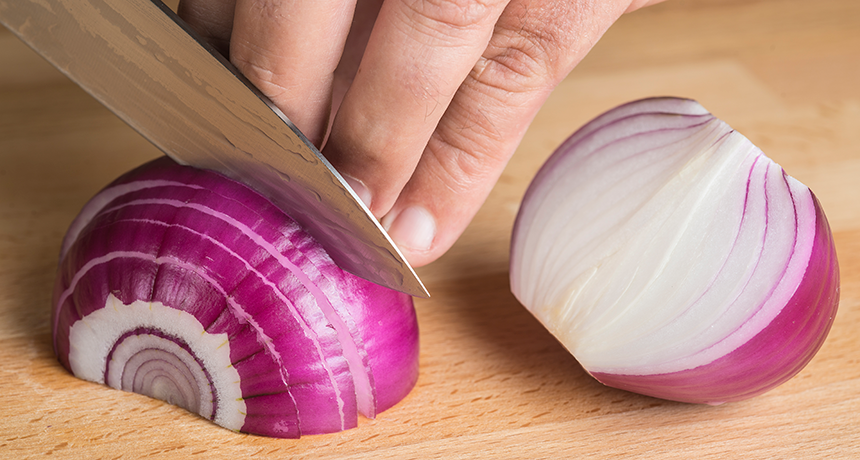Why onions make us cry
Scientists discover new clues to the complex steps involved in this common kitchen chemistry

A complex chemical reaction takes place when an onion is cut. The resulting compound is a real tear jerker.
angelsimon/istockphoto
Cut an onion and your eyes may start to burn and tears may run down your face. Scientists have been investigating why this happens for decades. Now some researchers have uncovered a new piece of the complex answer. They have figured out how one of the veggie’s eye-irritating compounds forms.
For a common vegetable, the chemistry of onions is surprisingly perplexing, says Eric Block. He wasn’t involved with the new study. Still, this chemist at the University at Albany in New York, does know a lot about onion chemistry.
Slice into it and you unleash a chain of chemical reactions, he notes. Stable molecules in the onion’s tissues transform into a volatile, sulfur-containing gas. This gas reacts with the eyes to form small amounts of sulfuric acid. Sulfuric acid can lead to itching, burning — and tears.
But the process is more complicated than that. He and other scientists have been struggling to come up with the full picture for more than 40 years. “The more compounds we discovered, the more complicated the picture became,” Block says.
Determining the chain reaction
Block has been working on the problem since the 1970s. He determined the structure of one of the onion’s eye-irritating molecules in 1979. This sulfur-containing chemical is called lachrymatory (Lak-RIM-uh-tor-ee) factor, or LF. (This comes from the Latin word lacrima, which means “tear.”)
The structure of any molecule shows the position of the different atoms that make it up. That structure also shows how the different atoms join together. “Knowing [LF’s] structure gave us clues about how the molecule formed,” says Block.

He knew that LF must start off as a different molecule. That’s because it only caused a tearing of the eyes once the onion’s skin was broken. He hypothesized that a chemical reaction must take place as an onion is cut. Block thought this chemical reaction must convert a stable molecule into one that could quickly vaporize and burn the eyes.
Sometimes chemical reactions need a little help to get started. That’s where enzymes come in. “Enzymes are amazing molecules,” he explains. They are nature’s fire-starter. Enzymes help to jump-start or speed up chemical reactions.
Block focused on an enzyme known as alliinase (AL-ee-un-ace). He showed that it helped to speed up the chemical reaction that converts sulfoxides (Sul-FOX-ides) — stable starter molecules in the onions — into eye-irritating ones. Certain plants, such as garlic and onions, make alliinase. It helps make the volatile chemicals that give these foods their savory flavors and aroma.
Later, in the early 2000s, scientists at a Japanese food company discovered a second important enzyme in onions. These scientists had been looking for a way to make a tearless onion. They thought they could do so by keeping alliinase from triggering the reaction that led to sulfuric acid. But when they isolated alliinase and mixed it with the sulfoxides, nothing happened.
That’s when they discovered LF synthase. The researchers reasoned that alliinase helped to change the shape of the starter molecule so that the second enzyme could go to work on it. Yet nobody knew for sure. The structure of that LF synthase was unknown. And without that information, researchers couldn’t decipher the complete chemical reaction.
Making crystals
Marcin Golczak is a biochemist at Case Western Reserve University in Cleveland, Ohio. Biochemists study the molecules at work in living things. Golczak and a team of researchers wanted to know how the eye-irritating LF forms. To do that, they turned LF synthase into a crystal. Now they could use a technique called X-ray crystallography to map its structure.
First, the researchers mixed the enzyme with an acid. This caused crystals to grow in the mixture. The researchers froze the crystals in liquid nitrogen. Then they used a special camera to shoot X-ray beams at the crystals. When those beams hit the crystal, the X-rays scattered. By measuring the angles of the scattered beams, the researchers could construct a 3-dimensional picture of the enzyme.
Golczak’s team combined this 3-D picture with the previous research findings of what the enzyme did. From this, they made a model of what the enzyme looks like. “Science is a building process. You don’t just discover one thing and then instantaneously know everything about how it works. There are many layers,” Golczak explains.
Block calls the new study the next logical step in solving a longstanding question. “It’s one small but critical piece of a puzzle,” he says.
Golczak’s team described what they did in the September 15 issue of ACS Chemical Biology.
As to why onions produce the eye-irritating chemical in the first place, Block says it probably helps the plant defend itself from predators. The chemicals that hurt human eyes might also trigger pain in other organisms. This would make the plant less appealing to wildlife, insects and even some bacteria or fungi.
“It’s an intricate reaction millions of years in the making,” Block says. “You can’t help but be in awe at the beauty of nature when you start to look at what’s happening around us on the [chemical] level.”







